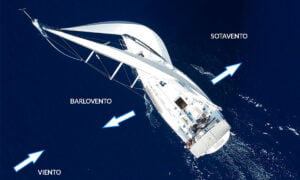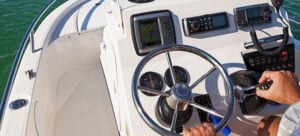Balance and Nose Movement: Definition
The concept of stability of a ship is none other than the property that it has to recover its initial state (righting) when a internal or external element (sea or wind) makes me lose it.
The state of the sea (waves) and the wind cause the ship to lose its initial position, causing it to oscillate. Those movements are the transversal is called balance and if they are longitudinal headers.
Transverse and longitudinal static stability
to) Transverse stability: When the ship is not affected by the sea or the wind, its position is that of upright, only two forces act on it, the gravity center (G), where they are supposed concentrated the weight of the ship, and the center of gravity of the submerged part called care center (C) which is where the pushing force. If the ship is upright, both centers are located in the same vertical.
When, due to sea or wind reasons, a heel is taken, the center of hull moves. The vertical that passes through that point cuts to the longitudinal plane (center line) is called metacenter cross. If that point remains, the metacenter, is located above G (center of gravity), the force torque that is generated is righting so the boat will recover its upright position.
Are you interested in: Definition of headings
However, if this point, the metacenter is left over below G (center of gravity) the torque formed is heeling and the boat overturns
When the vertical that passes through the center of the hull at its intersection with the longitudinal plane (center line) or what is the same, the metacenter coincides with the gravity center, the boat remains with the permanent list.
If we look at the figures we can see that both the heeling torque and the permanent heeling occur when we raise the center of gravity (G), therefore it is of utmost importance to keep in mind that When we lower the center of gravity we give more stability to the ship, what will be achieved losing weights, while if on the contrary we raise the center of gravity, stability is compromised.
b) Longitudinal stability: It is the tendency that the ship has to seat change. As the longitudinal stability torque is larger, it does not affect the ship. This stability It depends mainly on the length but also somewhat on the shape of the hull..
Ways of governing
To avoid swaying or nodding off as much as possible (duration time), it is necessary to break the synchronism, that is, we must avoid making the periods of the balances or pitches coincide with the period of the waves (time between two consecutive crests).
To break this synchronism and govern avoiding balances (transverse synchronism), or nods (longitudinal), we will try to govern in the following way:
- Cross: If the transverse period, which is the time taken by the ship between the inclination of one side and the other, is equal to that of the wave, it may produce an increase in the amplitude of the oscillation, an effect that can be corrected by changing course.
- Longitudinal: If the longitudinal period is equal to the waves, it can produce the same effect, which is corrected by changing the speed.
Importance of not crossing into the sea
Depending on the state of the sea and the place where it is received, it is advisable to reduce the speed, especially when the sea is coming from the bow in order to prevent the structure of the boat from suffering from the slumps, and that the sea blows can cause damage. boarding a lot of water on deck which can cause breakdowns. The machine can also suffer accelerations because, at times, the propeller comes out of the water (completely or partially), therefore, with the head sea the tack must be kept to sea with little machine due to be careful not to cross since its consequences can be fatal because could tip over relatively easily, this is a situation to avoid.
If the sea comes from the stern or from the fin, it must be taken into account that the waves are much more treacherous and that if the speed of the wave coming over the side matches the speed of the boat, it can cause it to sink. not release all the water embarked, therefore it must Make sure that this speed does not match, for which, if possible, the speed of the boat must be higher than that of the waves in order to prevent water from entering the stern. This way of sailing is not highly recommended since it is much more difficult to keep the boat on course. can be crossed to the sea leaving it exposed on the sides, which is a dangerous situation.





